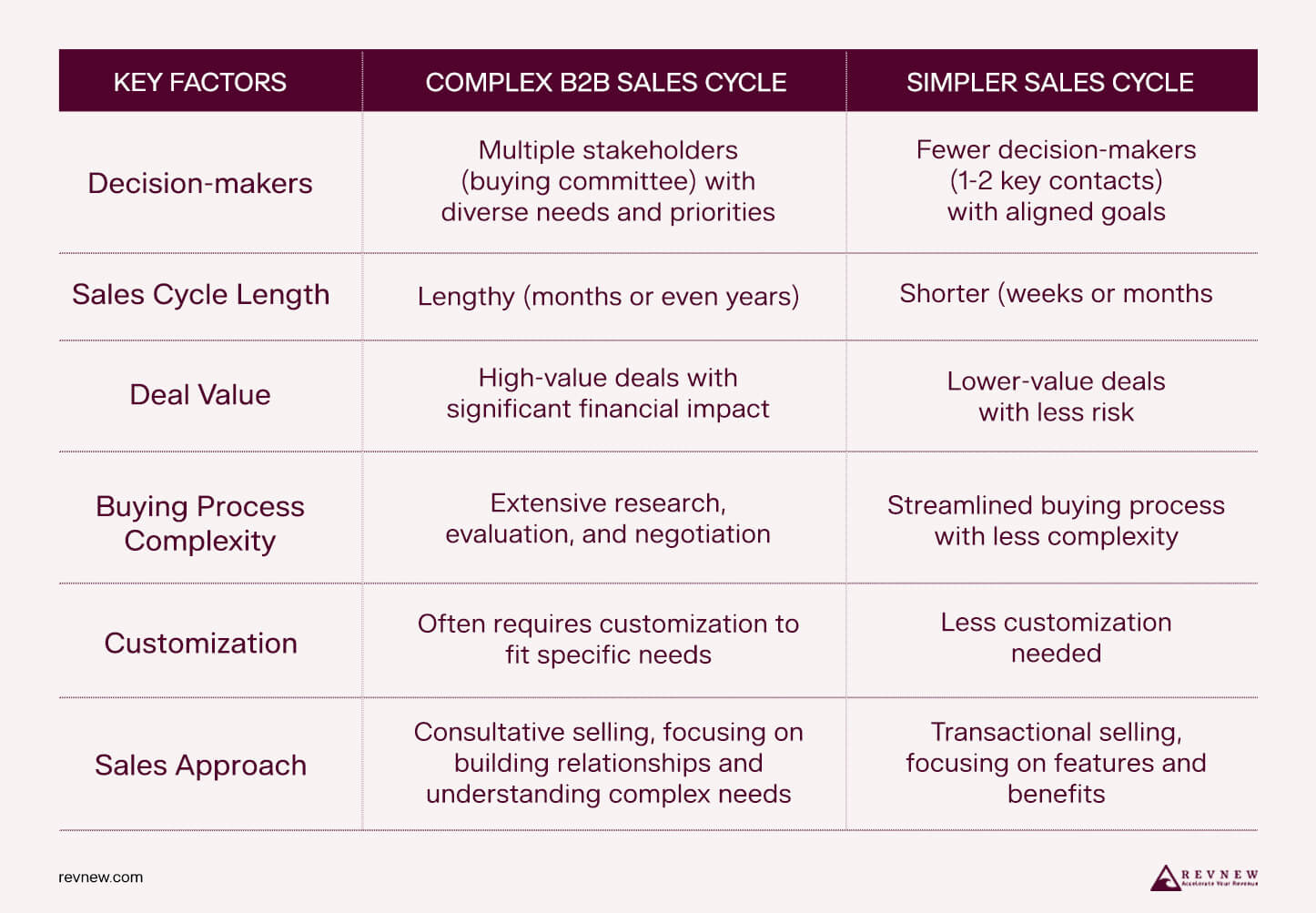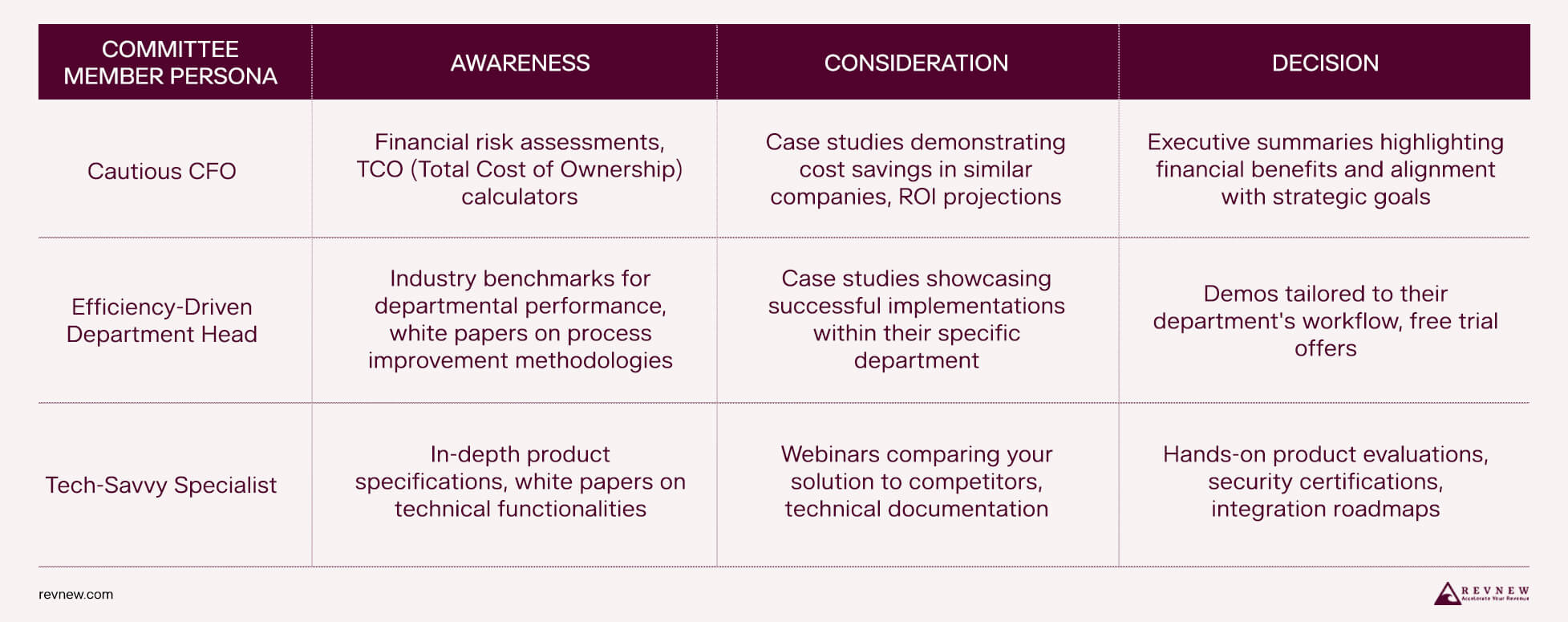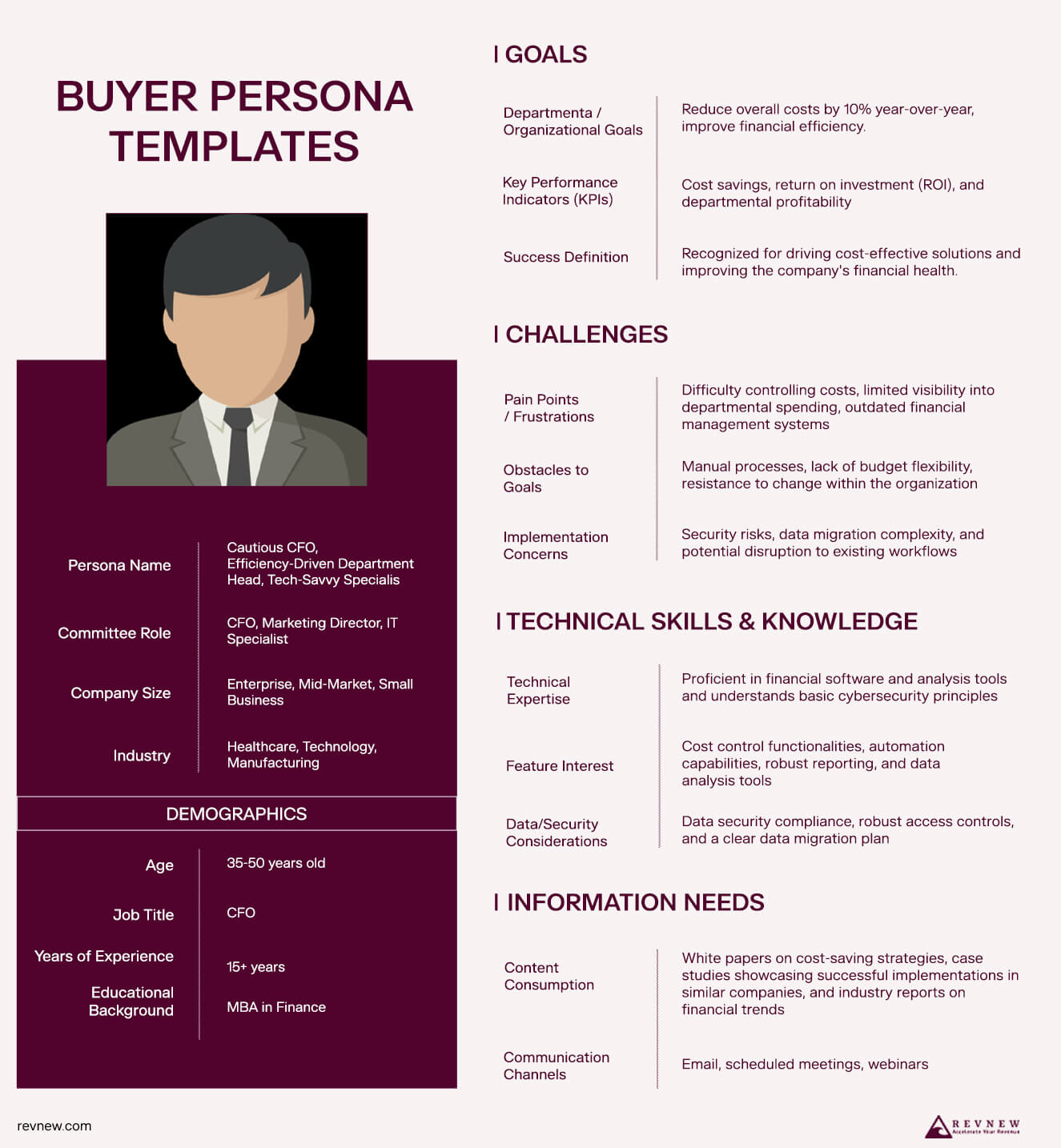
Build Buyer Personas for Complex B2B Buying Committees
Have you ever found yourself in a whirlwind of approvals and committee meetings? Welcome to the world of complex B2B sales cycles, where you often juggle an average of 11 stakeholders.
Research shows that buying committees have ballooned compared to a decade ago. This has made the sales journey more complex and purchase decisions harder to secure. In fact, this expansion has led to a 30% decrease in customers reaching purchase decisions altogether.
Understanding their diverse needs is the key to navigating this labyrinth and winning over these committees.
This guide will equip you with the tools to build buyer personas and craft targeted messages that resonate with each member. As such, you can conquer complex sales cycles and close those high-value deals.
Decoding Complex Sales Cycles and the Role of B2B Buying Committees
Complex B2B sales cycles involve the following key elements:
- Multiple Stakeholders: Each buying committee member has priorities and concerns, requiring a tailored sales approach.
- Lengthy Sales Cycle: The extended decision-making process involves multiple stages of research, evaluation, and approvals.
- High-Value Deals: The significant financial investment involved necessitates a thorough evaluation by the buying committee.
- Customization: Complex solutions often require personalization to meet the customer's specific needs, adding another layer of complexity.
- Consultative Selling: Understanding the intricate needs of each committee member and building trust is crucial for success.
Here's a table illustrating the key differences between a complex and straightforward B2B sales cycle:

As you can see, complicated B2B purchases necessitate the involvement of a buying committee. This committee acts as a decision-making powerhouse, carefully evaluating solutions and ensuring alignment with the organization's goals.
Who Are the Members of the Buying Committee?
Here's a breakdown of the typical players:
- C-suite Executives (CEO, CFO, COO): These high-level decision-makers focus on the big picture. They prioritize the solution's impact on the company's overall strategy and financial performance.
- Departmental Heads (Marketing Director, Head of IT, Sales Manager): These individuals represent specific departments with unique needs and challenges. They'll assess the solution's ability to improve their department's efficiency, productivity, and overall performance.
- Technical Specialists (Engineers, IT Experts): They ensure the solution's technical feasibility and integration. They delve into technical specifications, data security, and compatibility with existing systems.
Each member brings a distinct perspective, influencing the decision-making process differently. Understanding their priorities and concerns is crucial for crafting a compelling sales strategy.
Persona Power: Unlocking Insights for Targeted Outreach
Buyer personas are fictional representations of your ideal customers, built on research and data. In the context of complex B2B sales, these personas delve deeper, representing each buying committee member.
But how do buyer personas unlock insights for targeted outreach? By crafting buyer personas for each committee member, you gain a deeper understanding of their:
- Responsibilities: What are their specific roles and day-to-day challenges within the organization?
- Pain Points: What are their biggest frustrations and unmet needs related to the problem your solution addresses?
- Goals: What are their aspirations for their department and the organization?
With this knowledge, you can tailor your outreach to resonate with each member.
Next up…
How to Build Buyer Personas for Each Committee Member
Here's a step-by-step approach to building personas that illuminate the "who" and "why" behind each committee member:
1. Decode Their World
Utilize information sources, such as:
- Sales Data: Existing customer profiles reveal demographic patterns and typical responsibilities for each committee role within your target market.
- Industry Reports: Industry research delves into current trends and prioritizes different departments within your target customer base face.
- Competitor Analysis: Competing companies’ marketing materials and messaging can offer insights into how they position their solutions to different committee members.
2. Uncover Their Motivations
Don't settle for demographics alone. Conduct in-depth research to understand the inner workings of your ideal customer's buying committee:
- Sales Rep Interviews: Tap into your sales team's frontline knowledge. Interview them to uncover specific pain points and goals frequently encountered by each committee member type.
- Customer Interviews: Schedule interviews with existing customers (if possible) to get a firsthand perspective from different committee members on their:
- Buying journey
- Decision-making factors
- Overall experience
- Targeted Surveys: Supplement qualitative data with quantitative insights. The former can include the following:
- Preferences for communication channels
- Detailed feedback on past initiatives
- Personal motivations for committee participation
The latter can include the following:
- Number of events attended in the past year
- Rating scale responses on satisfaction with committee activities
- Percentage of members actively engaged in tasks
Design targeted surveys for each committee member persona to gather data on:
- Purchase motivators
- Decision-making criteria
- Preferred communication channels
3. Map Their Journey
The buying journey isn't a one-size-fits-all process. Map out each committee member's distinct stages (awareness, consideration, decision). Consider how their information needs differ at each stage. For instance:
- Awareness: During initial awareness, technical specialists might prioritize white papers and webinars that provide in-depth information about your solution's capabilities.
- Consideration: Department heads concerned with departmental performance might seek case studies showcasing successful implementations in their industry or department.
- Decision: C-suite executives focused on the big picture might require concise executive summaries. Such resources may highlight the solution's ROI and strategic alignment with the organization's goals.
Here is an illustration of the above:

Best Practices for Building Rock-Solid Buyer Personas
You need a solid foundation to build personas that resonate with your B2B buying committees. Here’s how:
1. Collaboration is King
Building robust buyer personas requires a symphony of insights from across your organization. Don't just rely on marketing's intuition! Involve representatives from various teams:
- Sales: The sales team is on the front lines, interacting directly with committee members. Their knowledge of buyer concerns, objections, and motivations is invaluable.
- Marketing: This department brings expertise in customer research, segmentation, and understanding broader market trends.
- Customer Service: This team provides a unique perspective on post-sale experiences and ongoing customer needs.
2. Data Drives Decisions
Buyer personas shouldn't be based on guesswork. Ground them in factual data to ensure accuracy and credibility. Here are some data sources to consider:
- Customer Relationship Management (CRM) Systems: A CRM can reveal buying patterns, demographics, and past interactions with committee members.
- Website Analytics: Web behavior can offer insights into information needs and content preferences.
- Industry Reports: They provide valuable context on your target market's trends, challenges, and priorities.
- Surveys and Interviews: Targeted polls and discussions with sales reps and existing customers help gather specific information about committee members.
3. The Need for Constant Evolution
The business landscape, customer needs, and buying committee dynamics can change. To ensure your buyer personas remain relevant, schedule regular reviews. Here's how:
- Set a Review Schedule: Establish a timeframe for revisiting your personas (e.g., quarterly or annually).
- Gather Updated Information: During reviews, incorporate new data from ongoing sales interactions, customer feedback, and industry research.
- Refine and Adapt: Don't be afraid to adapt your personas based on new insights. Revise information, adjust priorities, and ensure they continue to reflect the current buying landscape accurately.
Tools and Resources to Turbocharge Your Persona Development
Here's a toolbox filled with resources to streamline the development process:
1. Survey Platforms
Tools like SurveyMonkey and Google Forms allow you to easily create and distribute targeted surveys to sales reps and existing customers.
These surveys can gather valuable data on committee member traits, directly informing your persona development.
2. Marketing Automation Platforms
They offer built-in features specifically designed to streamline persona development.
These features might include:
- Data Management Tools: Organize and centralize customer data from various sources (CRM, website analytics) for easy access and analysis.
- Persona Building Templates: Utilize pre-built templates to jumpstart your persona creation process, saving you valuable time.
- Reporting and Analytics: Generate reports that provide insights into customer behavior and buying committee dynamics, helping refine your personas.
3. Buyer Persona Templates
Don't reinvent the wheel! Numerous online resources and marketing software providers offer downloadable buyer persona templates. Here’s an example:

These templates can serve as a starting point, providing a framework to capture key information for each committee member's persona.
Adapt these templates to your specific industry and target audience for a head start on building robust personas.
Conclusion
The labyrinthine world of complex B2B sales cycles can be daunting. However, with buyer personas as your guide, you can navigate the intricate paths and win over B2B buying committees. By understanding each member's motivations, priorities, and buying journeys, you can craft targeted messaging that resonates and builds trust.
Ready to unlock the power of buyer personas and conquer your complex sales cycles? Revnew can help! Contact Revnew today to learn how we can help you build winning buyer personas and transform your B2B sales strategy.




